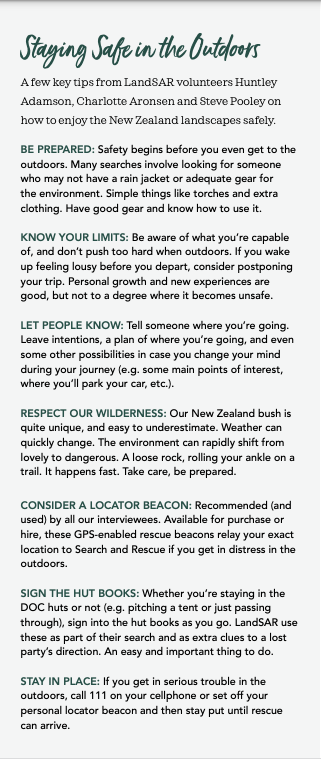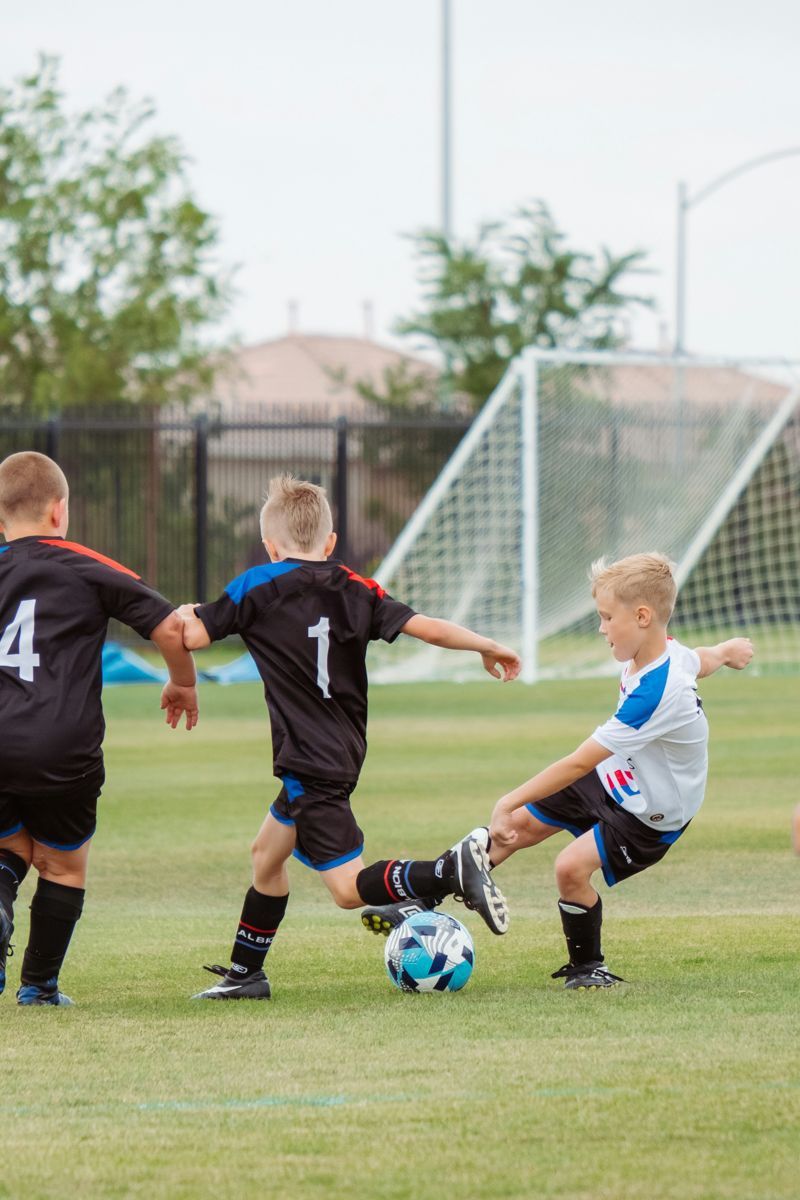From the archives we have a great read about the role LandSAR plays in our local community, as they celebrate 90 years of helping the lost, the missing and the injured.
Each year several hundred people go missing or get into trouble in our great outdoors. When help is needed, a range of ordinary Kiwis come to the rescue.
The call-out came to Steve Cooley around 9pm. A member of Oxford Land Search and Rescue (LandSAR) Group, Steve quickly gathered his gear and joined fellow volunteers at the local police station to assess the situation and plan the operation. A trail runner was overdue, the weather had closed in. Low cloud at sea level wouldn’t allow the rescue helicopter to fly. Worrying signs, a tricky situation. But this is what Steve and his LandSAR colleagues trained for, the type of situation they gave so much of their free time for. Someone might be in trouble, so they’d try to help.
Steve and two others were deployed at 10.30 pm to climb the hill where the trail runner was meant to be. Their mission: locate the runner or see if the cloud at higher levels may allow the helicopter to fly. A freezing cold night, a missing runner, 800 vertical metres to reach the summit. A tough situation, but the climb was worth it. Once the clouds were below them, Steve and his team could then see a flashing light coming from across another valley.
‘From there we could contact our management teams to advise them… As the higher altitude was clear and the temperature was dropping rapidly, well below freezing, the helo [helicopter] was dispatched to the flashing light first,’ recalls Steve now. ‘They retrieved the uninjured but very cold trail runner before returning for us and flying us back to our vehicles.’ A successful operation. Hot drinks well-earned. Another lost person, home safe.
‘Everyone gets home safe’ is the vision statement of LandSAR, a national organisation whose roots trace back to the 1930s. Nowadays it’s fuelled by the skills and efforts of people like Steve Pooley and 3,500 other unpaid, highly trained Kiwis from a huge variety of backgrounds. Serving the public and helping the police, 24 hours a day, seven days a week.
In recent years LandSAR has averaged about one call-out a day. Its volunteers have saved 600 to 1,000 people each year. All for free. Nineteen out of every 20 people who help provide an operational search and rescue response in New Zealand are volunteers, giving our country one of the highest rates in the world of volunteers involved in search and rescue.
Steve’s own Oxford LandSAR group has 37 members and is one of 10 groups operating across Canterbury, from Kaikōura to the Mackenzie, along with specialist teams like the Christchurch Alpine Cliff Rescue team, LandSAR Search Dogs, and LandSAR Caving.
‘Our group’s members come from all walks of life – tradesmen and farmers to architects and a microbiologist,’ says Steve. ‘I love being part of such a diverse group who have come together for the same reason and are willing to train so hard to do the best job possible.’
Charlotte Aronsen also enjoys that sense of collegiality and shared purpose among the range of people who volunteer with LandSAR. Charlotte works as a manager in the insurance industry and joined the Christchurch Search and Rescue Group, which covers the city and Banks Peninsula as well as assisting rural groups on larger operations, nearly six years ago. ‘I was probably one of those people who’d heard of LandSAR and had an understanding of what they did but I never thought I could be one of their volunteers,’ says Charlotte.
An office worker who enjoyed the outdoors, she’d just secured a couple of week-long stints as a volunteer hut warden in Nelson Lakes National Park when a friend of a friend suggested she join LandSAR. ‘It was one of those things where I hadn’t really thought about who would be involved in it. I knew LandSAR existed, but probably had a bit of a perception around what they’d be looking for in terms of experience and what they did day to day, as opposed to how it is, having such a wide range of people bringing different skills to the table.’
The Christchurch group has around 33 operational members, ranging in age from twenties to retirees, says Charlotte, along with several probationary members completing their fundamental training – the pathway to being able to go out on a search. ‘We’ve got anyone from my job, in management, to engineers. We’ve got an aircraft engineer, geologists, all sorts. We’ve had students before, people in their first jobs. Definitely a big range.’
Several years after he joined Hanmer Springs Search and Rescue, Huntley Adamson is now a training officer, helping volunteers increase and hone their skills. He was shoulder-tapped by the local police officer to consider joining LandSAR. The Hanmer group consists of around 15 volunteers, ranging from outdoors adventure staff and builders to the local gardener, plumber, and electrician. Their group receives about a dozen call-outs a year – around half of which are quickly resolved. Huntley says they’re always on the lookout for good volunteers.
Now a building apprentice, Huntley originally moved to the township as a secondary school teacher, so he enjoys being able to combine his loves of teaching and LandSAR. ‘That’s my passion, upskilling and getting people to the stage where they’re competent and confident and can make a real impact in helping people when they’re out there, and that they’re safe.’
Like Huntley in Hanmer, Steve is a training officer for his Oxford LandSAR group. Each local search and rescue group conducts its own regular training events for its members, supplementing the exercises and training run at a regional and national level.
For those keen to volunteer with LandSAR, or curious to find out more – a situation Steve, Charlotte, and Huntley were in six to eight years ago – the process to become a volunteer first involves contacting your local group, sharing information about any relevant experience, meeting with group members for an interview, then submitting an application for Search and Rescue Volunteer Security Clearance by the New Zealand Police. ‘LandSAR is run under the police system,’ explains Huntley. ‘So we’re not called out unless the police are notified. Then the police will call us, we group together and come up with a plan. In our area we communicate with the Christchurch Central Police Station, and that’s a fantastic system that works very well. Then we work hand in hand with our local police officer as well.’
Once accepted, new volunteers join their local group as probationary volunteers, and can join in with the huge variety of training on offer. ‘LandSAR offers a great range of courses from Search Techniques and basic Tracking (compulsory courses required for new volunteers to become operational) to Flood and Water Safety and Alpine skills,’ says Steve. ‘As group training officers we try to recreate the essence of these courses regularly in order to ensure all our members maintain a high level of competency over a wide range of skills.’
Charlotte says she found her Christchurch group really welcoming as a rookie as she learned alongside some other new volunteers, and there were ‘some really good people in the group who actively got involved in terms of talking with and engaging the new team members’.
While enjoying navigation exercises in the Port Hills, one of the challenges for Charlotte was learning about tracking.
‘You can tell the people who are more the hunters and things like that, where they’re able to discern where things have gone and tracks, they’re a lot more tuned in from the outset.
While I’ve done a bit of bush bashing, you’re not having to necessarily track something through the bush. I remember being at my first course and they had one of the trainers saying “So where has someone gone through here?”, and I was looking at it, completely blind to it, and a couple of other guys were like “It’s there and there.” But then they started showing you what you were looking for, and all of a sudden it clicks.’
While LandSAR volunteers need to have a level of fitness that allows them to move around in the outdoors, safely, for several hours at a time (stamina more than speed), and an interest in the outdoors, there’s no prerequisite to have worked in outdoor recreation or have first aid skills before becoming a volunteer. Ample training is provided across a number of vital areas.
‘Anyone can be a valuable member of a LandSAR group,’ says Steve. ‘Many different skills are required to run a search and these skills and experiences come from all walks of life. Especially as technology is playing an increasingly large part in SAR.’
Attitude is important, says Huntley, when I ask him what he’s looking for in a good LandSAR volunteer. ‘Someone that’s just willing to get stuck in. It’s never a pleasant time when there’s a call-out. I always wait for the day when there’s a call-out and it’s nice and sunny and I’ve got nothing else planned for the day, but that’s never the case – it’s always a Friday night and we’re about to have fish ’n’ chips and it’s raining, so that’s always a bit frustrating. But yeah, someone who’s willing to get stuck in, someone who’s a team player, someone who’s happy to contribute and not be worried if their idea might not be used. But all ideas are valid and very helpful for helping to put together the best search.’
Once a probationary volunteer has completed the foundational courses on search techniques and tracking, they’ll become operational and can then help on call-outs for a variety of missing people. It’s not always about overdue hikers in rural areas. Huntley’s first call-out was a search for a group of young boys who’d borrowed their father’s truck and rolled it on a farm. Charlotte and her group have also been involved with suburban searches, door-knocking as they look for someone with dementia who’s gone wandering, or a missing child.
‘While I think a lot of people have the perception with LandSAR that you’re always out in the mountains, we can end up doing street searches and ones where you’re checking people’s yards,’ says Charlotte. ‘You’re always with a team of people. It might be the case where you’re actually going and knocking on doors and talking to people, seeing if they’ve seen anything. Asking if you can search the perimeter of their section, just to see if anybody has got lost and doesn’t know where they are. We get a few of those. It’s quite a different search to be involved in because there’s a lot of community engagement. You have to be quite comfortable talking to people and talking about what you’re doing and why you’re doing it.’
Every time Steve, Huntley or Charlotte receive a call-out, it brings with it a mix of feelings as they grab their gear and head to the police station. Excitement, purpose, apprehension. Most call-outs have a successful outcome, where ‘everyone gets home safe’. But not always. Occasionally a missing person is not found. Sometimes they’re found, but not alive.
Being a volunteer for LandSAR offers a great sense of community, teamwork and accomplishment, agree Charlotte, Huntley and Steve, but also brings with it challenges beyond tiredness, tough weather conditions and tricky landscapes.
Last year Huntley’s group had a call-out where they were used for body recovery. Huntley himself wasn’t involved in that search because he was out of the area at the time, but he was still affected as it was someone he and his LandSAR colleagues all knew. ‘That’s when it can become quite tough, because you’ve got a job to do, but you’ve also got a connection with family and community.’ LandSAR does have ‘really fantastic’ support set up for its volunteers – approachable, available and non-judgemental, says Huntley. Which is vital, as everyone involved knows that while they’re putting in so much time and effort, so much training and teamwork, often in really tough conditions, to prepare themselves for all eventualities and give themselves the greatest chance of a successful search (the usual result), there can still be tough outcomes.
Despite those tough days, Steve, Charlotte and Huntley all love being part of LandSAR. ‘It is an awesome organisation run, manned and staffed by a hugely committed, knowledgeable and passionate group of people who work incredibly hard to help whenever possible and it is a privilege to be involved,’ says Steve.
Charlotte loves it so much she’s now the group secretary, running their social media pages and helping with fundraising. ‘I think LandSAR’s a really positive organisation. I like the fact that I can enjoy the outdoors but also do something for the community and help people.’

Recent stories








